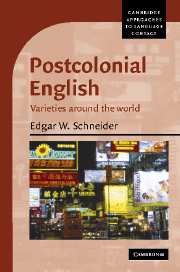Book contents
- Frontmatter
- Contents
- List of maps, figures, and tables
- Series editor's foreword
- Preface and acknowledgments
- List of abbreviations
- 1 Introduction
- 2 Charting the territory: Postcolonial Englishes as a field of linguistic investigation
- 3 The evolution of Postcolonial Englishes: the Dynamic Model
- 4 Linguistic aspects of nativization
- 5 Countries along the cycle: case studies
- 6 The cycle in hindsight: the emergence of American English
- 7 Conclusion
- Notes
- References
- Index of authors
- Index of subjects
3 - The evolution of Postcolonial Englishes: the Dynamic Model
Published online by Cambridge University Press: 15 December 2009
- Frontmatter
- Contents
- List of maps, figures, and tables
- Series editor's foreword
- Preface and acknowledgments
- List of abbreviations
- 1 Introduction
- 2 Charting the territory: Postcolonial Englishes as a field of linguistic investigation
- 3 The evolution of Postcolonial Englishes: the Dynamic Model
- 4 Linguistic aspects of nativization
- 5 Countries along the cycle: case studies
- 6 The cycle in hindsight: the emergence of American English
- 7 Conclusion
- Notes
- References
- Index of authors
- Index of subjects
Summary
Transforming selves in migration: theoretical background
In section 3.2 of this chapter I introduce the Dynamic Model of the evolution of PCEs, which claims that despite all surface differences there is an underlying uniform process which has driven the individual historical instantiations of PCEs growing in different localities. In the present section I outline some theoretical prerequisites which have informed this model. It operates within the confines of language contact theories in general, for instance as surveyed by Thomason (2001), and, more specifically, it adopts an evolutionary perspective emphasizing the importance of linguistic ecologies and the idea of new language varieties emerging in a competition-and-selection process between features available to speakers in a “feature pool” of possible linguistic choices (Mufwene 2001b, 2005a). In particular, it rests upon the assumption that, in selecting from this pool, speakers keep redefining and expressing their linguistic and social identities, constantly aligning themselves with other individuals and thereby accommodating their speech behavior to those they wish to associate and be associated with.
Language contact: processes, perspectives, scenarios
PCEs have emerged in language contact situations, so a theory of language contact provides a necessary frame of reference. While some branches of linguistics, in particular historical linguistics in models like the family tree, have emphasized the purity and homogeneity of languages, the ubiquity of language contact in almost all cultures around the globe has recently been recognized and established, and language contact theory has come to be a growing sub-discipline of linguistics.
- Type
- Chapter
- Information
- Postcolonial EnglishVarieties around the World, pp. 21 - 70Publisher: Cambridge University PressPrint publication year: 2007



